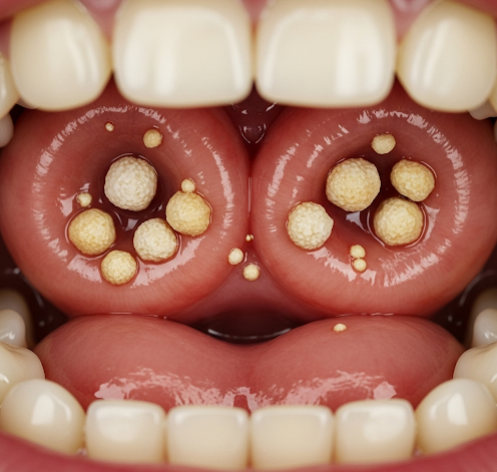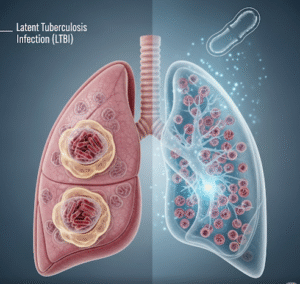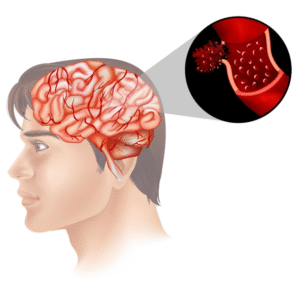Overview
Tonsil stones, medically known as tonsilloliths, are small, calcified formations that develop in the crevices of the tonsils. They are typically composed of bacteria, dead cells, mucus, and food particles that become trapped and calcified over time. While generally harmless, tonsil stones can cause discomfort, bad breath, and throat irritation. In South Korea, ENT specialists provide both non-invasive and surgical treatment options for managing tonsilloliths. Awareness, proper oral hygiene, and timely intervention are essential for preventing complications and maintaining oral health.
What is Tonsil Stones?
Tonsil stones form when debris accumulates in the crypts or crevices of the palatine tonsils. Over time, this debris calcifies, creating firm, white or yellowish stones. These stones can vary in size, from tiny specks to larger masses that are visible without medical imaging. Though usually asymptomatic, some individuals experience discomfort, persistent cough, or halitosis (bad breath). Korean ENT clinics often recommend conservative management initially, progressing to minimally invasive or surgical interventions for recurrent or symptomatic cases.
Symptoms
Symptoms of tonsil stones can vary depending on size, number, and location:
- Small, white or yellowish lumps visible on the tonsils
- Persistent bad breath (halitosis) caused by bacterial accumulation
- Throat irritation, scratchiness, or a feeling of something stuck
- Difficulty swallowing or mild discomfort while eating
- Ear pain due to referred sensations along shared nerve pathways
- Chronic cough or throat clearing
- Swelling or redness in the tonsillar area in some cases
While some patients remain asymptomatic, others may experience significant discomfort impacting daily life.
Causes
Tonsil stones form due to a combination of anatomical and environmental factors:
- Deep tonsillar crypts: Natural crevices in the tonsils where debris can accumulate
- Chronic tonsillitis or inflammation: Recurrent infection increases debris and bacterial colonization
- Poor oral hygiene: Bacterial accumulation accelerates stone formation
- Post-nasal drip: Mucus from sinus infections or allergies can contribute to debris buildup
- Dietary factors: High dairy intake or excessive mucus-producing foods may increase risk
- Age and anatomy: Certain individuals are more prone due to larger tonsils or deeper crypts
In Korea, dentists and ENT specialists emphasize proper oral care and early intervention to reduce formation risk.
Risk Factors
Several factors increase the likelihood of developing tonsil stones:
- Chronic or recurrent tonsillitis
- Large tonsils or deep tonsillar crypts
- Poor oral hygiene or infrequent dental care
- Smoking or exposure to environmental pollutants
- Sinus infections or chronic post-nasal drip
- Age, with young adults commonly affected
Early identification of risk factors allows ENT specialists in Korea to implement preventive strategies and minimize recurrence.
Complications
Although tonsil stones are usually benign, they can lead to complications if left untreated:
- Persistent halitosis affecting social interactions
- Throat irritation, pain, or discomfort
- Difficulty swallowing or chronic throat clearing
- Recurrent tonsillitis due to bacterial colonization
- Rarely, infection or abscess formation in the tonsillar area
- Potential ear pain from referred nerve irritation
Korean ENT clinics focus on both symptom management and preventive care to reduce the likelihood of these complications.
Prevention
Preventive measures are aimed at reducing debris accumulation and maintaining oral hygiene:
- Regular brushing, flossing, and tongue cleaning
- Gargling with saline or antiseptic mouthwash
- Adequate hydration to reduce mucus accumulation
- Treating chronic sinus or post-nasal drip conditions
- Avoiding smoking and limiting irritant foods
- Routine dental check-ups for early detection of potential issues
In Korea, awareness campaigns and dental guidance emphasize preventive oral care to minimize tonsil stone formation.
Treatment Options in Korea
Treatment of tonsil stones in Korea depends on severity, symptoms, and recurrence:
Conservative Treatments:
- Manual removal: Using sterile tools or gentle techniques for small stones
- Gargling and irrigation: Saline or antiseptic solutions to dislodge stones
- Laser tonsil crypt reduction: Minimally invasive procedure to reduce crypt depth
- Good oral hygiene: Prevents new stone formation
Medical Treatments:
- Antibiotics: In cases of secondary bacterial infection or recurrent tonsillitis
- Anti-inflammatory medications: To reduce local swelling or discomfort
Surgical Treatments:
- Tonsillectomy: Complete removal of tonsils for recurrent or severe cases
- Partial tonsil removal (tonsillotomy): Preserves some tonsil tissue while removing problematic crypts
Supportive Care:
- Pain management and soothing throat sprays for discomfort
- Hydration and dietary adjustments to reduce mucus accumulation
- Follow-up visits to monitor recurrence and prevent complications
South Korean ENT specialists combine minimally invasive techniques, medical management, and patient education to ensure effective treatment and long-term prevention of tonsil stones.













